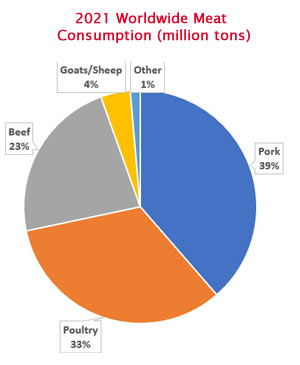According to the United Nations Food and Agriculture Organization (FAO), the global consumption of meat reached an impressive 340 million tons in 2021. This represents an annual increase of 1.4%, signaling a continued upward trajectory from the previous year. The FAO esitamtes that about 83% of the world’s population consumes meat on a regular basis. This means that about 6.5 billion people eat meat at least once a day. As outlined below, the percentage of people who consume meat varies greatly from country to country.
Pork remains the most consumed meat globally, comprising 36% of the total meat consumption. Poultry is the second on the list, forming 33% of the global share. Beef, although holding the third spot, still makes up a substantial 24% of worldwide meat consumption. The preference for goats and sheep signifies a lower but not insignificant 5% of global consumption. Other types of meat, such as lamb, turkey, duck, and goose, cover the remaining 2%.
These statistics about global meat consumption conceal the disparities that exist from country to country. In China, pork stands out as the favored meat, representing a notable 62% of the nation’s meat consumption. Conversely, the United States demonstrates a leaning towards beef, which forms 44% of its meat intake. In India, a different pattern emerges with chicken being the most popular, accounting for 37% of meat consumption.
Notably, religious beliefs often intersect with dietary habits, influencing the types of meat consumed. The Islamic faith prohibits the consumption of pork, while Hinduism places restrictions on beef consumption, both rooted in their respective religious doctrines.
To understand the dynamics of global meat consumption, it is crucial to delve deeper into the underlying factors, which span cultural, religious, economic, and environmental realms.
Cultural Factors
Culture often leaves an indelible mark on dietary preferences. Certain cultures may consider specific meats taboo, restricting their consumption entirely. Conversely, other cultures may elevate the status of certain meats, making them central to their culinary tradition.
Religious Factors
Religion can significantly impact meat consumption patterns, as seen in the dietary guidelines of Islam and Hinduism. Religious convictions often classify certain animals as sacred or unclean, which directly impacts dietary choices within these communities.
Economic Factors
Economic considerations also play a pivotal role in meat consumption. The affordability of meat can affect consumption levels; in regions where meat is costly, individuals tend to consume less. Conversely, where meat is more affordable, it often constitutes a larger part of the diet.
Environmental Factors
Increasingly, the environmental impact of meat production is swaying consumer choices. The meat industry contributes significantly to greenhouse gas emissions, water pollution, and deforestation. Consequently, growing awareness of these impacts is leading some consumers to reconsider their meat consumption, with many opting to reduce or even eliminate meat from their diet.
Navigating global meat consumption trends involves considering a multitude of factors. For food industry professionals, understanding these various aspects can help to develop products and strategies that resonate with different consumer groups, taking into account cultural, religious, economic, and environmental concerns. Weighing the pros and cons of meat consumption can better inform decision-making, contributing to a more sustainable and responsive food industry.

